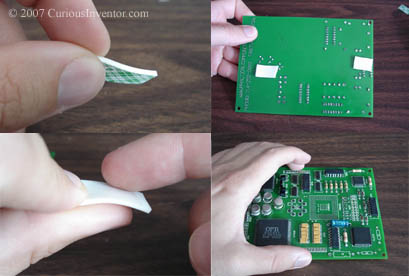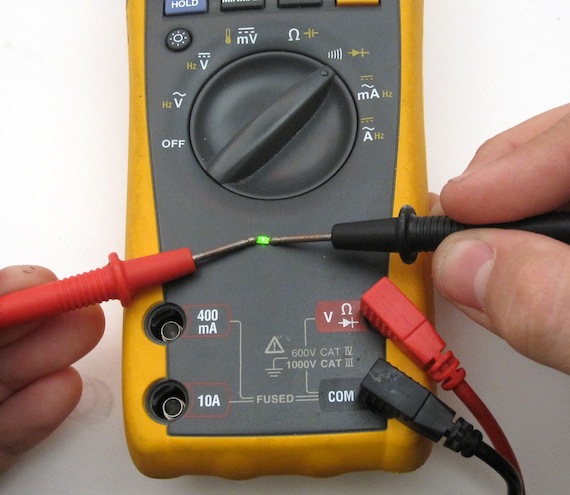
While SMT leds typically have a dot or small green line indicating their cathode, it can be hard to remember. A quick way to test a LED is by touching the ends with a multimeter in ‘Continuity Test’ mode. The multimeter generates a small voltage in order to detect a closed circuit, and this is enough to light the LED. Although we couldn’t burn out any LEDs with this Fluke, there’s no guarantee your meter won’t over-do the current, so we recommend doing just a quick touch, or putting a resistor in line.
Eagle vs KiCad
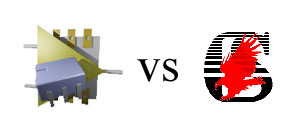 Inspired by Steve Chamberlin’s post evaluating kicad vs eagle for someone new to both, here are some more opinions from the perspective of someone who uses both equally, (about 20 projects for both), but is certainly not an expert at either.
Inspired by Steve Chamberlin’s post evaluating kicad vs eagle for someone new to both, here are some more opinions from the perspective of someone who uses both equally, (about 20 projects for both), but is certainly not an expert at either.
Summary: Eagle is more straightforward, has better library support of out of the box, and better community support (ladyada, sparkfun, etc.).
Kicad is free, and is maybe 1 or 2 revisions from being great.
Click the entry for our list of pros and cons:
Here is a random list of pros and cons:
- libaries:
- Eagle has great library support out of the box; sparkfun and ladyada’s libraries are great. Dealing with libraries in eagle is a little more straightforward. When you place a part in eagle’s schematic, you’ve already selected the layout package, where is with kicad, you need to use a 3rd program, CvPCB, to map the schematic symbols to the packages. Chamberlin pointed out that this is a pain when you’re trying to pick the right package out of a list of 400, but you can actually filter the list to the potential candidates using the filtered display.
- There are a lot of existing kicad libraries available, including a kicad port of the eagle libraries.
- For every kicad project, you have to add the symbol and package libraries in the project’s preferences before using them. With eagle, one “use” command and you’re good forever.
- Learning Curve:
- We give eagle a 6 hour time to go through a tutorial or two, and figure out how to make new components. Chapter 17 of the eagle tutorial (on libraries) is a must read. Kicad gets a 10 hour estimate to go through some tutorials and wrap your head around the libraries, along with getting past a few quirks. We’ve got a kicad tutorial if you’re looking.
- Highlighting:
- When you highlight a trace or component in eagle, it highlights in both the schematic and layout view. In kicad, there’s no way to highlight nets in the schematic view. This makes it hard to see when things aren’t connected. Sometimes components overlap lines in kicad schematic, but then aren’t actually connected in the netlists.
- Undo:
- The layout editor in kicad has no undo, except for undeleting parts. (this feature could very well be in the latest version).
- Routing:
- The shortcuts in kicad are great for quickly moving components and flipping between layers. You can also “hug” traces, which lets you places traces as close as your design rules permit. This helps to quickly make 4 lane parallel paths that zig and zag.
- Price:
- Non-profit: Eagle is free for 100 x 80 mm (4 x 3.2 inches) boards limited to 2 layers, non-profit. For $125 you can do up to 6 layers, 160x100mm (6 x 4 inches), also non-profit.
- Any use: Light (100x80mm, 2 layers):$49. Standard (6 layers, 160x100mm): $500 for schematic+layout. And there’s also pro for you 12 layer motherboard manufacturers. $1500 for everything.
- kicad is free and open source.
Conclusion: This is by no means an exhaustive list (more experienced users please weigh in!), but our guess is that eagle would be faster for someone just starting out until you want to sell your project or make that 7in+ long pcb, in which case getting past the kicad quirks is worth the effort.
Video: How to Solder QFN MLF chips Using Hot Air without Solder Paste and Stencils
This video demonstrates how to solder a QFN or MLF chip without solder paste or stencils. While solder paste and a stencil will product the most consistent results, this demonstration only uses an iron, flux, hot air and regular solder to get the job done.
Future videos will demonstrate how to use a solder paste syringe, as well as the recommended method of using a stencil.
Equipment used in this video:
- Aoyue 6028 Hot Air SMD Rework Station
- Tweezers for Surface Mount Devices (SMDs)
- Alcohol Dispensing Pump Bottle
- Chipquik No-Clean Paste Flux Syringe
- Liquid Flux
- Flux / Alcohol Bottle
- Desoldering wick/braid
- .02 SAC (lead free) solder
- Horse Hair Brush (ESD safe when wet)
- Hakko 50W Soldering Station
- 10X Magnifying Loupe
Make Your Desk a White Board
Inspired by the desks at atlanta’s hackerspace, we made a new work station with a white board as a surface. For $12, you can get a 8×4 foot piece of panel board from Home Depot / Lowes.
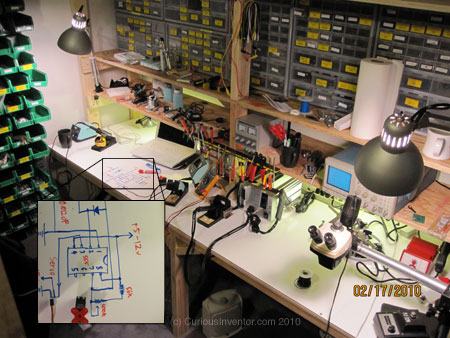
Cheap DIY BreadBoard Jumpers
If breadboard jumper kits seem too expensive, you can easily make your own with 22 AWG solid core wire. Just strip off a half inch of insulation from the ends and you’ll be able to make hundreds of jumpers for the price of a small spool.
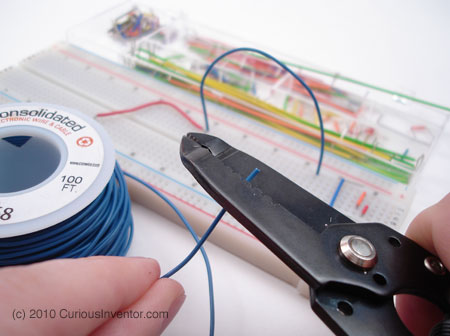
Techniques for Finding Shorts in Printed Circuit Boards
After ordering a new pcb and populating all the components, sometimes you’ll find a short between two signals. This can be especially hard to track down if it’s touching a gound or power signal that travels all over the board. Worse yet, sometimes the short is on an internal layer and can’t be seen.
Common Causes:
- A small solder bridge or ball between pins: Sometimes small strands of solder will bridge two pins–this is especially easy to do on “bard bones” boards without any solder mask. Using too much solder paste, or paste that’s past it’s prime, can also lead to bridges or small balls getting lodged behind pins. The balls are especially hard to remove since solder wick usually can’t reach them. Sometimes a thorough flooding of solder followed by more wicking will work.
- Incorrect components / pinouts: Make sure the pinout on that spare voltage regulator you had lying around actually matches the layout connections.
- PCB manufacturing erros: Sometimes you’ll find hair-line connections where they shouldn’t be, especially in areas close to the manufacturer’s limits.
David at uCHobby.com had some good tips for finding shorts in printed circuit boards.
-
- The obvious thing to try is to start removing components and isolate sections of the board. This may also require cutting a few traces.
- If you’ve already taken all the components off, and carefully checked over the board for obvious errors, try running a few amps through the offending traces. If it’s a hairline pcb manufacturing mistake, the small thread of conductor will burn up under the amperage. Your other traces, even ones as small as 8mils, should be fine for a short time under a few amps.
- Lastly, if you’ve narrowed down the short but can’t see it because it’s inside the board, it might be time to drill. David had some horror stories about drilling through 10 layer boards to fix one trace while breaking traces in 7 other layers. Have some “green” or “white” wire handy to jumper the broken traces.
Any other ideas for quickly locating a short without resorting to board surgery or removing all your painstakingly placed parts?
poor man’s clamp
When soldering a lot of surface mount chips, or when you don’t have a clamp handy, sometimes the best solution is just a piece or two of double-sided tape between the board and desk. “De-stick” the tape a little by touching it with your fingers to avoid permanent additions to your desk and to make it easier to rotate the board when needed. Only a small amount of tape is needed.
